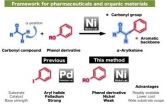(Press-News.org) Scientists armed with a supercomputer and a vast trove of newly collected data on the body's most potent "tumor suppressor" gene have created the best map yet of how the gene works, an accomplishment that could lead to new techniques for fighting cancers, which are adept at disabling the gene in order to thrive.
Scientists from the University of Colorado Cancer Center and the University of Colorado Boulder used a new technology to tease out how the p53 gene—which is responsible for recognizing damaged DNA in cells and then marking them for death—is actually able to suppress tumors by determining what other genes p53 regulates. The study, published in the journal eLife, describes dozens of new genes directly regulated by p53.
The study authors say further research can explore which of these genes are necessary for p53's cancer-killing effect, how cancer cells evade these p53-activated genes, and how doctors may be able to moderate cancer cells' ability to stay safe from these genetic attempts at suppression.
The exhaustively studied p53 gene—which has been the subject of 50,000 papers over more than 30 years of research—is the most commonly inactivated gene in cancers. When p53 acts, cells are stopped or killed before they can survive, grow, replicate and cause cancer.
As such, all cancers must deal with p53's anti-tumor effects. Generally, there are two ways that cancer cells do this: by mutating p53 directly or by making a protein called MDM2, which stops p53 from functioning.
The current study explores cancer cells' second strategy of blocking p53 function by producing the protein MDM2. Researchers have reasoned that treating a patient with an MDM2 inhibitor should allow p53 to restart its anti-cancer activities.
"MDM2 inhibitors, which are through phase I human trials, effectively activate p53 but manage to kill only about one-in-20 tumors," said Joaquín Espinosa, an investigator at the CU Cancer Center, an associate professor of molecular, cellular and developmental biology at CU-Boulder, and the paper's co-senior author. "The question is why. What else is happening in these cancer cells that allow them to evade p53?"
The answer is in what are called "downstream" effects of this gene, Espinosa said. The gene p53 doesn't act against cancer alone. Instead, it is the master switch that sets in motion a cascade of genetic events that lead to the destruction of cancer cells. And until now, it was unclear exactly which other genes were directly activated by p53.
The imperfect knowledge of p53's effects isn't for lack of research interest. Researchers have written thousands of papers exploring p53's targets and, in fact, many genetic targets are previously known. Most of these studies determine genetic targets by measuring levels of RNA.
When a gene is activated, it creates a protein. But between the gene and its protein product is the measurable step of RNA—the more gene-specific RNA, the more often a gene's informational blueprint is carried to the cell's manufacturing centers, and the more protein is eventually made. Researchers measure RNA to see which genes are being turned up or down by any other gene.
"But the problem is, measuring overall RNA levels is like looking in a huge bucket full of water—you see the water but you don't really know where it came from. And imagine you are dripping water into this bucket—it takes a long time for those drips to create a measurable change in the overall water level," Espinosa said.
Also, it's very difficult with traditional methods to tell whether increased RNA is a direct effect of a gene or whether more RNA in the bucket is a product of two- or three-steps removed signaling. The p53 gene may activate another gene, which activates another, and down the line until the far downstream result is increased RNA.
"Instead, to measure the direct genetic targets of p53, we measured not the water in the bucket, but the faucet dripping into it," Espinosa said.
The technique is called GRO-Seq, or Global Run-On Sequencing, and it measures new RNA being created, not overall RNA levels.
"Many teams around the world have been getting cancer cells, treating them with MDM2 inhibitors and waiting hours and hours to see what genes turn on and then only imprecisely. GRO-Seq lets us do it in minutes and the discoveries are massive," Espinosa said.
The technique also generates an astounding quantity of data. That's because it requires counting tens of thousands of RNA molecules before and after p53 activation.
So the experiment required designing algorithms—sets of instructions for solving problems—to sort through the data, and a computational biologist driving a supercomputer.
Espinosa partnered with computational biologist Robin Dowell at CU-Boulder's BioFrontiers Institute. Together they co-mentored a postdoctoral fellow, Mary Allen, who was capable of doing both the molecular biological and computational aspects of the work.
"The data collection took a year and the computational analysis took a year and a half," Dowell said.
The results helped the scientists pinpoint dozens of new genes directly regulated by p53, which may lead to future cancer-fighting strategies.
The technique of GRO-Seq also may have additional, far-reaching applications. For example, the Dowell lab plans to find RNAs whose synthesis is changed by a third copy of chromosome 21 in Down Syndrome individuals.
INFORMATION:
The study was supported by the Howard Hughes Medical Institute, the National Institutes of Health, the National Science Foundation, a Boettcher Foundation Seed Grant and the Boettcher Foundation's Webb-Waring Biomedical Research program.
New University of Colorado study illuminates how cancer-killing gene may actually work
2014-05-27
ELSE PRESS RELEASES FROM THIS DATE:
Why retailers need to pay attention to the smell of their stores
2014-05-27
This news release is available in French. Montreal, May 27, 2014 — Retail stores overflowing with merchandise can make consumers feel claustrophobic rather than ready to spend. But the recent move towards open, minimally stocked spaces can leave them feeling just as anxious.
The solution to this shopping conundrum may be smell, as new research from Concordia University shows.
In a study recently published in the American Journal of Business, researchers from the university's John Molson School of Business (JMSB) suggest that, when diffused in retail environments, ...
Imaging scientists develop a better tool for tracking MS
2014-05-27
Imaging scientists at Western University's Robarts Research Institute (London, Canada) have developed a better way to track the progression of Multiple Sclerosis (MS) from its earliest stages. Led by Ravi Menon, PhD, the researchers used what's called "Quantitative Susceptibility (QS) Magnetic Resonance Imaging (MRI)," to measure damage in specific areas of the brain which the study showed to be common to all patients. The findings are published in advance online, in Radiology.
"In MS research, there is something we call a clinical-radiological paradox. When ...
Steroids prescribed in the ICU linked to delirium
2014-05-27
New Johns Hopkins research suggests that critically ill patients receiving steroids in a hospital's intensive care unit (ICU) are significantly more likely to develop delirium. Results of their research, they say, suggest minimizing the use of steroids could reduce delirium in the ICU.
While it usually goes away after a few days, studies show delirium in the ICU has a long-term impact. It has been associated with worse functional recovery and cognitive impairments of a magnitude consistent with moderate traumatic brain injury or mild Alzheimer's disease.
Overall, up ...
HSP90 is a potential target for ameliorating skeletal muscle abnormalities in PD
2014-05-27
Heat shock protein (HSP90) has been suggested to be involved in neuronal protein misfolding and accumulation in Parkinson's disease (PD) brains leading to dopaminergic neuronal death and the eventual dopamine depletion. Therefore, HSP90 has been suggested as a therapeutic target in PD. Dr. Muhammed Al-Jarrah and co-workers from Jordan University of Science and Technology (JUST) point out exercise training significantly inhibited HSP90 overexpression in the soleus and gastrocnemius in PDe rats, which is a potential therapeutic target for ameliorating skeletal muscle abnormalities ...
A new 'Kabuto-like' nickel catalyst forms bioactive frameworks from phenol derivatives
2014-05-27
Researchers at ITbM, Nagoya University developed a new nickel catalyst with a "Kabuto-like" structure that was found to catalyze the cross-coupling reaction between carbonyl compounds and readily available phenol derivatives, to form alpha-arylketones, which are found in many biologically active compounds (Kabuto = a helmet worn by Japanese samurai).
Nagoya, Japan – Professors Kenichiro Itami and Junichiro Yamaguchi of the Institute of Transformative Bio-Molecules (WPI-ITbM) and graduate students Ryosuke Takise and Kei Muto of Nagoya University have succeeded in developing ...
New tick-borne disease threatens primarily immune suppressed persons
2014-05-27
A newly discovered tick-borne bacterium known as "Candidatus Neoehrlichia mikurensis" has been implicated in six cases of disease in Sweden. A new international study led by the Sahlgrenska Academy has shown that this bacterium is primarily a risk for people who are already sick and who are receiving immunosuppressive drugs.
The Candidatus Neoehrlichia mikurensis bacterium, known in the medical world by its short name Neoehrlichia, was discovered and described for the first time in a scientific article in 2010.
The bacterium, which is spread by rodents and ticks mainly ...
New jigsaw piece for the repair of DNA crosslinks
2014-05-27
Environmental influences such as ionizing radiation, intense heat or various chemical substances damage the DNA constantly. Only thanks to efficient repair systems can mutations – changes in the DNA – largely be prevented. DNA crosslinks that covalently link both strands of the DNA double helix are among the most dangerous DNA lesions. Crosslinks block DNA replication and can thus cause cell death. Moreover, their faulty repair can trigger the development of tumors. Crosslink repair is highly complex and only vaguely understood today. A team of cancer researchers headed ...
X-ray dark-field radiography provides detailed imaging of lung diseases
2014-05-27
As the team reports in the Investigative Radiology journal, this method shows promise in detecting diseases such as pulmonary emphysema at an earlier stage, than it is currently available. Conventional radiographic procedures generate images based on the absorption of X-rays as they pass through the tissue. The newly developed technique of X-ray dark-field radiography uses new technology to monitor wave changes during tissue transmission to create higher resolution images.
Detailed images
With the aid of this new technique, the team from the HMGU, KUM and TUM around Dr. ...
Two new possible drug targets for triple negative breast cancer
2014-05-27
HOUSTON -- ( May 27, 2014 ) -- The suppression of two genes reduce breast cancer tumor formation and metastasis by interfering with blood vessel formation and recruitment, report scientists from Houston Methodist and five other institutions in the Proceedings of the National Academy of Sciences (now online). The findings may help medical researchers identify effective drug targets for triple negative breast cancer, or TNBC.
The genes, MLF2 (myeloid leukemia factor 2) and RPL39 (a ribosomal protein), were found to most profoundly impact the production of nitric oxide synthase, ...
Large numbers of shadow economy entrepreneurs in developing countries, according to new report
2014-05-27
There are large numbers of entrepreneurs in developing countries who aren't registering their businesses with official authorities, hampering economic growth, according to new research.
Shadow entrepreneurs are individuals who manage a business that sells legitimate goods and services but they do not register it. This means that they do not pay tax, operating in a shadow economy where business activities are performed outside the reach of government authorities. The shadow economy results in loss of tax revenue, unfair competition to registered businesses and also poor ...


